
25 Contemporary Artworks you need to see

Contemporary art is a period that is generally considered to span from the post-war period to present day. It encompasses numerous different styles, genres and artistic approaches, and so is difficult to fully comprehend. That’s where Artsper comes in! Today we’re breaking down 25 key contemporary artworks that you need to know to fully understand this artistic period!
1. Andy Warhol, Campbell’s Soup Cans, 1962

One of the world’s most famous contemporary artworks is artist Andy Warhol‘s Campbell’s Soup Cans. Symbolic of the Pop Art movement, the piece illustrates consumerist culture and mass media in American society. In addition to this, Warhol’s signature style is visible in his work. Through the repetition of the represented object, the artist reflects his critique of a consumerist society and its endless cycle of production and consumption.
2. Louise Bourgeois, Maman, 1990

Standing at a height of 30 meters in the shape of a spider, Maman is an iconic sculptural artwork by Louise Bourgeois. Various versions of the piece exist, created using a diverse range of materials. Built for an exhibition at the Tate Modern, it pays homage to Bourgeois‘ mother, who died suddenly when the artist was just 21.
3. Jackson Pollock, Autumn Rhythm, 1950

Created at the peak of Jackson Pollock’s career, Autumn Rhythm is a perfect example of the drip-painting technique. The technique, which is specific to Pollock, made him famous due to its originality. To create his works, Pollock stood on his canvas and dripped diluted paint onto the canvas, letting it fall naturally. He would drip, splash, scrape and pour paint onto his canvas. For the artist, the movement and paints themselves drove his art. This unique method of painting is considered to be the artist’s trademark.
4. Njideka Akunyili Crosby, I Still Face You, 2015

A young and dynamic artist, Njideka Akunyili Crosby unites her dual cultural experience in her vibrant contemporary artworks. After spending her formative years in Nigeria, she moved to America at the age of 16 and now lives and works in Los Angeles. Her intensely personal pieces unite her rich cultural influences with more “traditional” acetone paintings superimposed on complex sets, which are often a collation of elements taken from Nigerian folk culture.
5. Damien Hirst, The Physical Impossibility of Death in the Mind of Someone Living, 1991

Preserved in formaldehyde, the work The Physical Impossibility of Death in the Mind of Someone Living by Damien Hirst today remains one of the most controversial contemporary artworks in history. The original piece was commissioned by collector Charles Saatchi in 1991, but the shark had to be replaced in 2004 when the piece was sold. Due to the nature of the work, many wonder whether or not the piece should be considered art.
6. Cecily Brown, The Girl Who Had Everything, 1998
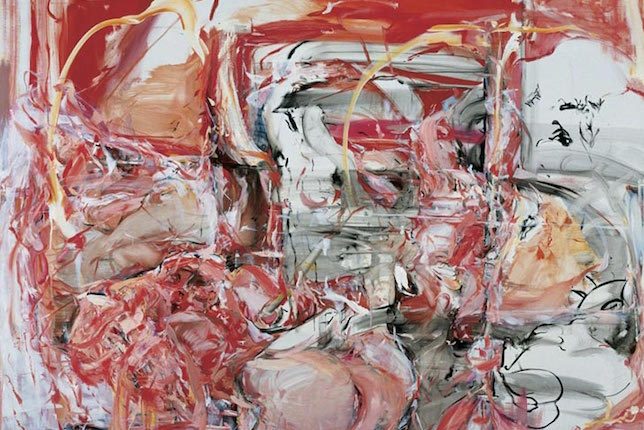
British artist Cecily Brown is known for her luxurious and extremely textured contemporary artworks. Her art is a mix between that of the baroque masters and abstract expressionism. She mixes color and texture with sexually suggestive figures and biomorphic forms that stand out against the abstract swirls that dominate her paintings. By simply alluding to forms rather than offering a concrete representation, the artist forces the viewer to examine the paintings in depth, from which the erotic images come into focus.
7. Yayoi Kusama, Infinity Mirror Room, 1965

Japanese artist Yayoi Kusama has been described as being one of the most eccentric artists of our time. Her psychedelic and hallucinatory work use motifs and repetition to play with the concept of infinity. Infinity Mirror Room is an immersive installation designed to engulf the viewer/ participant in an overwhelming sense of infinity and possibility. Kusama has described her life as “a pea lost among thousands of other peas”.
8. Keith Haring, Untitled, 1982
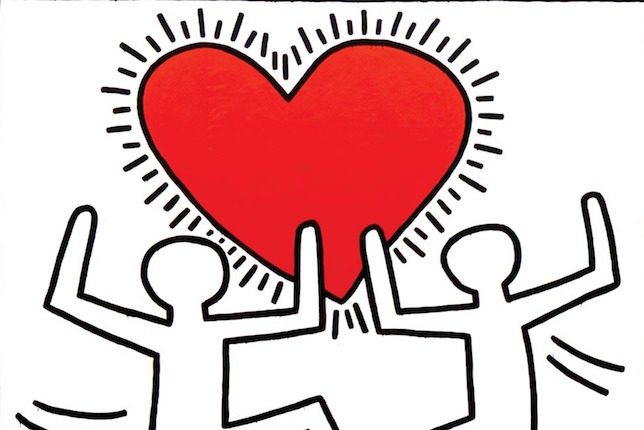
This painting sums up the Pop Art style of Keith Haring, with dynamic figures and a simple composition. From his beginnings as a graffiti artist on the New York subway, Keith Haring began his career with his immediately recognizable figures and patterns. One of his most commonly represented symbols is the heart. He used his work to popularize important messages about sexuality and AIDS during a time when the stigma and taboo surrounding these topics were still prevalent.
9. Jean-Michel Basquiat, Untitled, 1981
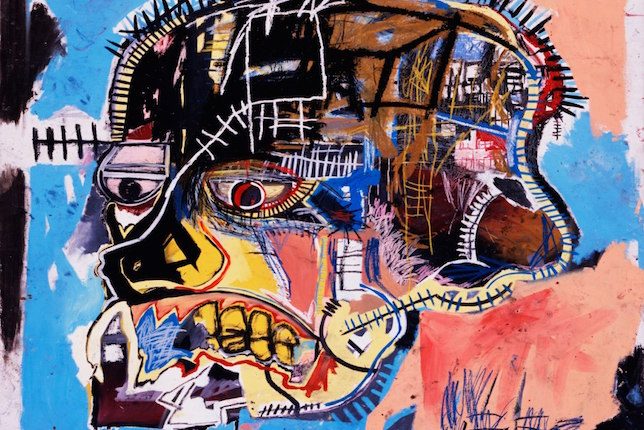
This vibrant and dynamic work of art, painted when Jean-Michel Basquiat was just 20, is considered a kind of enigma by art critics. Sometimes called “Skull” because of the shape of the face, this complex composition certainly raises more questions than it provides answers. Does it depict a skull or a half formed face? Does the painting represent life or death? Some even wonder if it is not a kind of self-portrait of the artist.
10. Jenny Saville, Propped, 1992

The painting that launched the career of Jenny Saville is a striking self portrait. Saville made a name for herself with her large portraits (often self-portraits), depicting women who do not conform to societal beauty standards, but who reflect the grand diversity of beauty in women. Her distinctive handling of oil paintings and her warm skin tones are reminiscent of Lucian Freud and Francis Bacon.
11. Banksy, Girl with Balloon, 2002

This iconic street artist first appeared on Waterloo Bridge in London, although since then it has been repainted. This work has been repeated many times in support of various political campaigns, notably the Syrian refugee crisis in 2014. In 2018, a framed copy of the work spontaneously shredded during an auction at Sotheby’s, thanks to a device that Banksy himself installed in the frame. He re-titled the shredded work, Love is in the Bin. The buyer who had purchased the print for a record price decided to proceed with the sale.
12. Tracey Emin, My Bed, 1998

My Bed, as indicated by the name, is a reconstruction of the artist’s unmade bed. Tracey Emin has said that this idea came to her after a long period of depression caused by difficult relationships and alcoholism. After recovering from her depression, she was disgusted by the mess that had accumulated in her room and decided to expose it. The work was nominated for the Turner Prize, which sparked a huge controversy over whether or not it should qualify as art.
13. Roy Lichtenstein, Look Mickey, 1961

With Look Mickey, Roy Lichtenstein represented a scene and style belonging to pop culture for the first time in his career, a step towards an art style that would become his signature. His reconstruction of a pre-existing scene, right up to the speech bubble, has led many to describe the work as an insult to the fine arts. Nevertheless, this unique style came to be celebrated. Today he is considered as one of the pioneers of the Pop Art movement.
14. Takashi Murakami, Flower Ball, 2002

Artist Takashi Murakami initially trained in the traditional Japanese art of Nihonga, before becoming frustrated by the elitism associated with the genre. He invented the term “superflat” at the beginning of the 2000s to describe the legacy of 2D art in Japanese culture through a long legacy of anime and manga, but also to address post-war Japanese society.
15. David Hockney, Portrait of an Artist (Pool with Two Figures), 1972

Considered the most expensive work of art by a living artist ever sold at auction, Portrait of an Artist is one of the most iconic pieces by David Hockney. The work was created using two photographs that were staged by the artist. The first version of the work was destroyed. However, a second version was repainted over two weeks in 1972.
16. Dorothea Tanning, Door 84, 1984

This work by Dorothea Tanning marks the beginning of the evolution of figurative Surrealism towards more abstract compositions, thanks to loose, dynamic strokes and bright colors. The artist created this work using oil paint and a door segment. However, this is not one of the artist’s most well-known works. In fact, the artist became particularly famous for her works Birthday (1942) and Eine Kleine Nachtmusik (1943).
17. Jeff Koons, Balloon Dogs, 1994
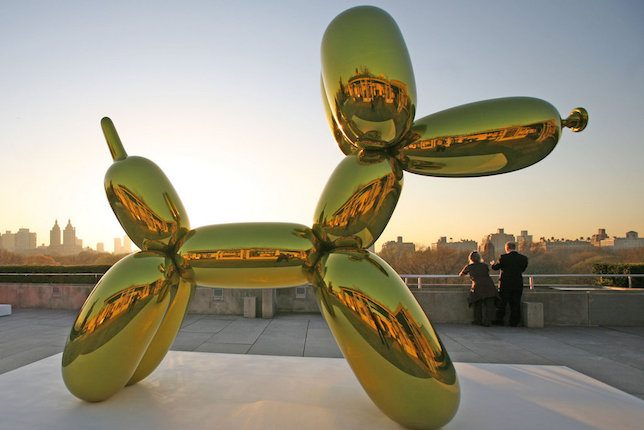
Former Wall Street trader Jeff Koons is a very controversial figure in the world of art. He has admitted that his work holds no deeper meaning message beyond aestheticism. What’s more, he uses a workshop to bring his visions to life and therefore doesn’t create his works himself. For these reasons, many question whether or not his works can legitimately be considered art. His metallic Balloon dogs are arguably the most recognizable of his contemporary artworks.
18. Marc Chagall, ceiling of Paris Opéra Garnier, 1964

The ceiling of the Opera Garnier in Paris is without doubt one of the most famous works by Chagall. It has caused significant controversy since its creation and its official opening in 1964. In fact, the various panels were assembled under protection from military guards. This vibrant piece only affirms Chagall’s status as “one of the great painters of our time”, containing references to famous composers and artists from throughout history.
19. Frida Kahlo, Self Portrait, 1948

This striking self-portrait was the last that Frida Kahlo painted. Self-portrait is the only piece created by the artists in 1948 due to her deteriorating health. In this work, Frida Kahlo wears the traditional dress of Tehuana in Mexico, with an embossed collar framing her face and replacing her usual natural background. The sharpness of her face and pained expression accentuates her profound emotion.
20. Lucian Freud, Reflection, 1985

British artist Lucian Freud is known for his figurative depictions. All his pieces are autobiographical, and his self-portraits were made with the help of mirrors. This work is a perfect example of the artistic style of its creator: each line, every defect of his face and skin are visible. The grandson of the psychologist Sigmund Freud is considered by many to be an artist who portrays his subjects in a brutalist manner. He therefore offers the public a glimpse into their minds and their worlds.
21. Sophie Calle, Prenez soin de vous, 2007

In 2007, Sophie Calle’s boyfriend ended their relationship by email, ending with the words “take care of yourself”. Sometime later, the artist distributed this email to 107 women, chosen for their professional expertise, and asked them to interpret his words. The answers include linguistic criticism, legal analysis, dance interpretations, coding, and even a short film of a cockatoo slowly eating the printed note. The different responses are brought together in this extraordinary exploration of relationships and vulnerability.
22. Antony Gormley, Angel of the North, 1998

Anthony Gormley is known for his anthropomorphic statues. These are often based on casts of his own body. Angel of the North is one of the most well known works by this artist. It is located in Gateshead in the United Kingdom. It was constructed over four years and cost around £800,000 to build. The wings are slightly tilted inwards, suggesting an embrace. In addition, the sculpture is intended to represent the passing of time.
23. Ai Weiwei, Remembering, 2009
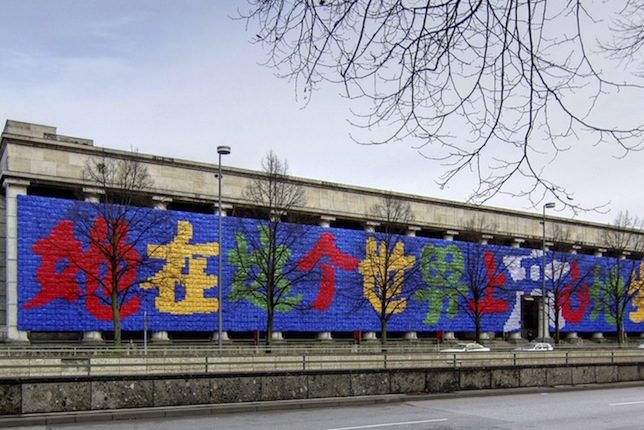
The Chinese artist Ai Weiwei created this striking piece in order to pay homage to the child victims of an earthquake that took place in the Sichuan province in 2008. Particularly devastating, the natural disaster tore down many schools. These were poorly constructed and as a result led to the death of many children. The large scale work is composed of 9,000 student backpacks. The spectator can read the Chinese characters “she lived happily in this world for seven years”. This sentence is a quote from a grieving mother about her lost child.
24. Francis Bacon, Three Studies of Lucian Freud, 1969
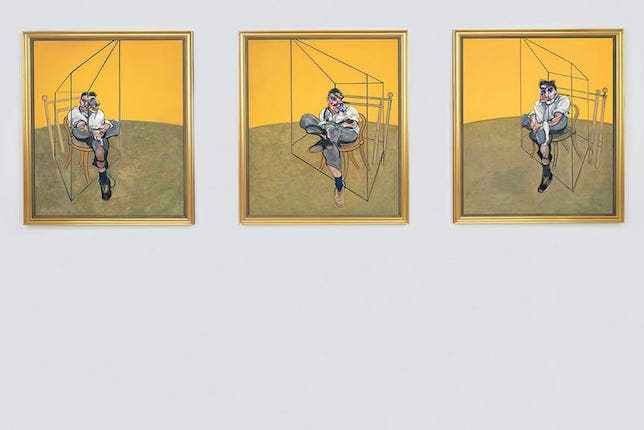
Sold complete 2013, this triptych became the most expensive work of art sold by a British artist. It represents the friend and rival of the artist, Lucian Freud. Francis Bacon has always emphasized the importance of not separating the three studies. However, this has not always been possible, with the 3 canvases separately changing ownership many times over the years.
25. Mark Rothko, Orange, Red, Yellow, 1961

In 2012, Orange, Red, Yellow, beat records at auction during its sale. Known for his geometric abstraction and vibrant colors, Mark Rothko has received as much criticism as he has praise. Rothko made his works on a very large scale. For the artist, his work had to be “very intimate and human”. He recommended that the spectator stand 60 feet away from his works to fully experience the intimacy and transcendence between the work and the audience.
Whose contemporary artworks will you discover next?
While you’re now familiar with these iconic contemporary artworks, there’s so many more to discover! Explore Artsper’s catalogue of contemporary artworks by both famous and emerginig artists!

About Artsper
Founded in 2013, Artsper is an online marketplace for contemporary art. Partnering with 1,800 professional art galleries around the world, it makes discovering and acquiring art accessible to all.
Learn more













